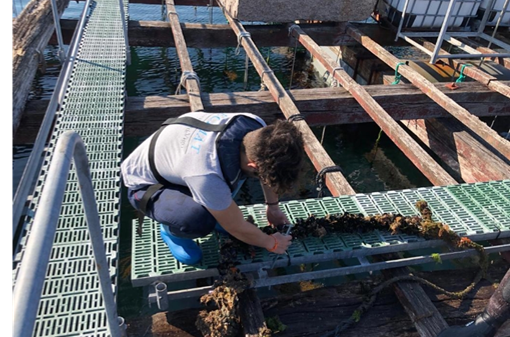Frozen assets

An important discovery for mussel hatchery production was announced in August, with the publishing in Nature of results from a long-term study funded by the ASSEMBLE Plus project.
The report, Long‑term study on survival and development of successive generations of Mytilus galloprovincialis cryopreserved larvae, by P Heres, J Troncoso and E Paredes, showed that adult mussels can be grown from cryopreserved larvae without compromising the quality of the next generation’s offspring.
The aim of the research was to optimise an established cryopreservation protocol for blue mussel larvae, to evaluate whether adult mussels could be successfully produced from cryopreserved 72 hour-old D-larvae, and to look at the potential long-term effects of cryopreservation on future generations.
The researchers achieved a “first” in producing spat (baby mussels) from cryopreserved larvae of M. galloprovincialis, which is one of the most commonly farmed mollusc species in the world.
To achieve their aims and update the protocol, the researchers undertook short-term experiments using different larval stages, cooling and thawing rates, along with a range of different cryoprotecting agent combinations and variations in the removal step for that agent.
Longer-term experiments were used to show that the optimised protocol allowed the production of mussel spat from cryopreserved mussel larvae. Further work was also undertaken to monitor the resulting mussel juveniles as they were ongrown using traditional rafts in a marine environment. A final long-term experiment worked with the subsequent second (F2) generation, which were cryopreserved using the same optimised protocol.
Trials found that spat developed into adult mussels and reached marketable size at the same growth rate as control individuals. Fertility and offspring quality of the new adults was unaffected by the cryopreservation process and were comparable to those from control mussels.
Improved reliability
Natural spat collection is the norm in many countries, but its timing and quality can be unreliable. The researchers pointed out that where shellfish aquaculture relies on hatchery-produced spat, the practice is also highly dependent on catches of wild seed.
Lead researcher Dr Estefania Paredes, from the University of Vigo, said: “Shellfish aquaculture needs the development of new tools such as this to reduce its reliance on natural spat collection, whilst improving good practices and efficiently increasing production. The results signify strong evidence for the suitability of this cryopreservation method for use in mussel aquaculture and in research, where animals must be in optimal health.”

Pablo Heres
In the wild, adult M. galloprovincialis mussels release gametes into the natural environment, where external fertilisation occurs. The fertilised eggs first develop into ciliated trochophore larvae, then after 24 hours, metamorphose into D-larvae. Around 20–24 days post-fertilisation, the larvae develop into pediveligers, grow an eye spot and a foot organ. Within another few days, they metamorphose into juveniles and are ready to settle on a suitable substrate.
In Europe, wild mussels are generally collected from hard substrates for hatchery spat production, and the juveniles settled onto culture ropes which are placed in the water, to allow the shellfish to grow to marketable size.
However, seed collection has become imperilled by an increasing number of issues in the past decade, including changes in seasonal spawning patterns, pollution and environmental degradation, the occurrence of pathogens, predation, high density of marine traffic, agriculture runoff, and the presence of intensive residential or industrial facilities along the coast.
Climate change is another factor to consider, with rising sea temperatures, acidification which can affect shell thickness, deoxygenation of the ocean, collapse of the marine food chain, and an increase in algal blooms.
Efforts have been made in France, for example, to boost protection at local, national, and European levels. Through the introduction of coastal zone management in some areas, changes to coastal law, water law, bird directives and regulations concerning the preservation of natural habitats, wild flora and fauna, the researchers hope that the situation will improve for the shellfish industry.
This is especially important as a number of mass mortality events have been noted in the mussel and oyster population in France over the past decade, which has significantly impacted European blue mussel (M. edulis) production.
According to researchers, the main cause appears to be “genomic abnormalities related to stock origin but could be also associated with environmental contaminations or a sign of disseminated neoplasia disorder.”
Research applications
Mussels are an important indicator species of environment quality and are often used in ecotoxicological bioassays and monitoring programmes, so the ability to produce consistent and reliable quantities of seed for research is equally important to this sector.
The paper points out that historical research has focused on developing methodologies to produce spat efficiently under optimal hatchery conditions, and selective breeding programmes are being used to improve certain characteristics, such as colour or increasing growth rates.
Use of cryopreservation tools is beneficial to selective breeding programmes, by offering the possibility of storing biological samples at high densities without the need to maintain live brood stocks.
The research was the first time that a cryopreservation protocol for M. galloprovincialis larvae has been investigated in depth from fertilisation to juvenile, to adult, and on to production of a second generation. Its success provides evidence of the suitability of the cryopreservation method for aquaculture or research purposes.
Further research is now recommended to investigate factors involved in the cryopreservation process, such as membrane permeability. The aim would be to improve post-thaw success, diminish cell injury and result in overall higher survival rates. The occurrence of high mortality rates and the delay in development of cryopreserved larvae in the first hours after thawing also needs to be investigated.
However, the work shows the high potential of cryopreservation to benefit the mussel industry, and the suitability of the technique for selective breeding programmes, which – the researchers conclude – is one of the most promising ways to increase global production.
Long-term study on survival and development of successive generations of Mytilus galloprovincialis cryopreserved larvae (Heres, P., Troncoso, J. & Paredes, E.) is available to view or download at go.nature.com/3eluqfO


